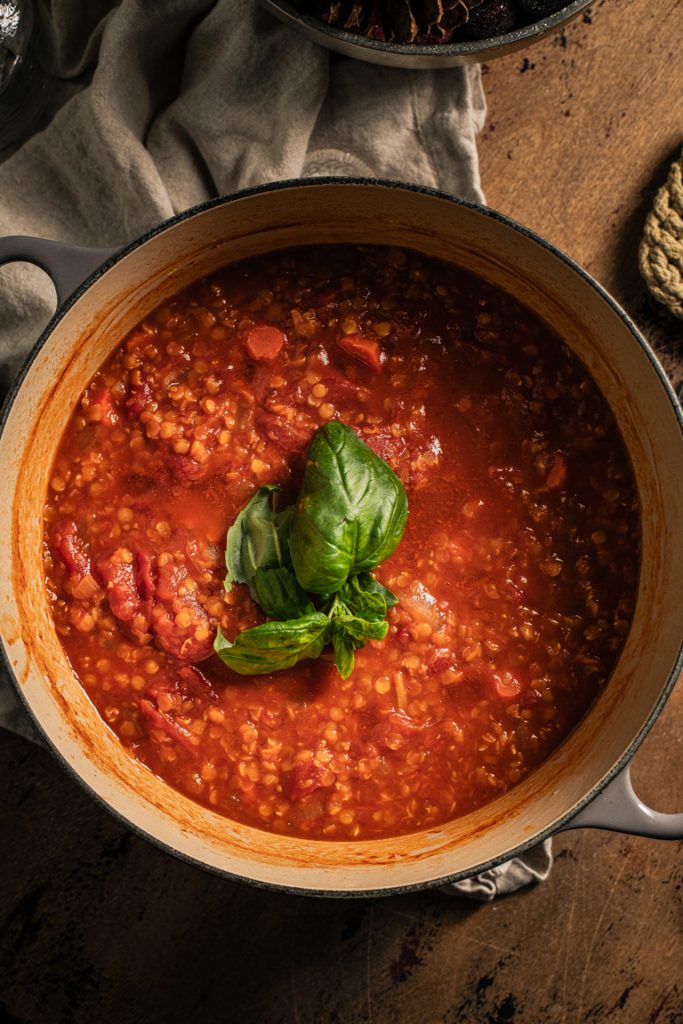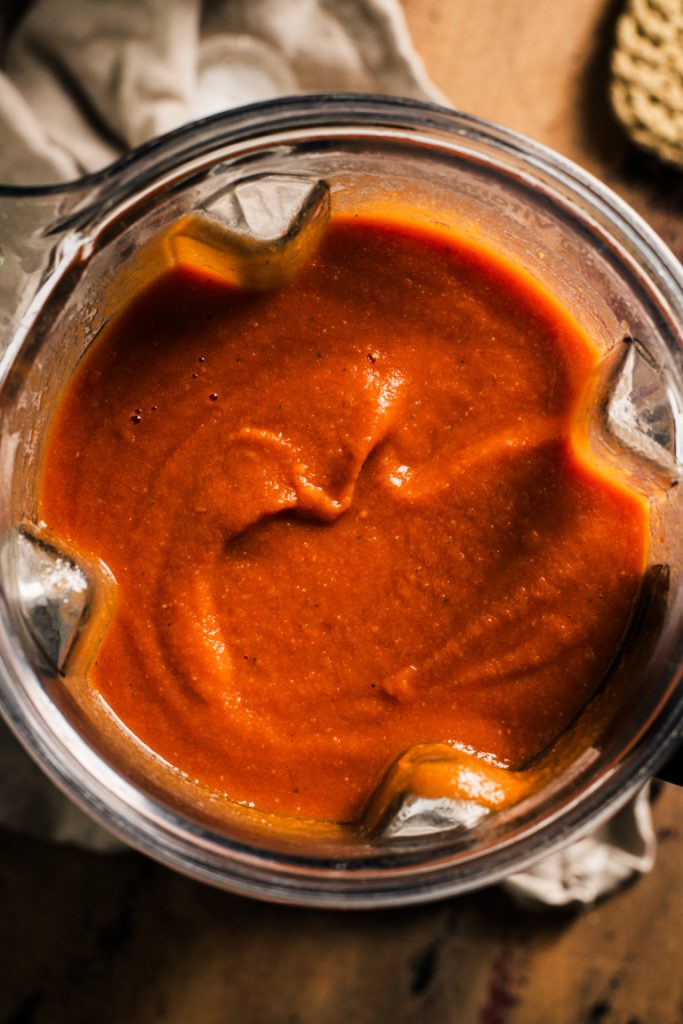This hearty and easy Red Lentil Tomato soup recipe has it all! It's cozy, comforting and super nourishing! It's got that classic tomato soup flavor you love but supercharged with protein and the amazing health benefits of red lentils. This tomato soup is so creamy and rich you won't believe it's also dairy-free, gluten-free and vegan as well. Enjoy a warm bowl with your favorite rustic bread, croutons or scoop it up with a slice of gooey grilled cheese!

Ingredients for Red Lentil Tomato Soup
In my January newsletter, I talk about how to stock a healthy plant-based pantry and fridge. Having these basic ingredients on hand means you'll be able to whip up a delicious and hearty soup like this one in no time at all! For this recipe, here's what you'll need:
- red lentils
- whole peeled tomatoes
- low sodium vegetable broth
- brown sugar
- carrots
- onion
- bay leaf
- fresh basil
- coarse salt & white pepper
- olive oil

How To Make Red Lentil Tomato Soup
It couldn't be easier to make this comforting soup. With just a few simple steps you can have a healthy soup ready in just over 30 minutes.
- Start by sautéing the aromatics (onions and carrots).
- Then add the tomatoes, broth and red lentils. Toss in the bay leaf and season with a bit of salt.
- Bring to a low boil, then simmer until lentils are broken down and soft (about 25 minutes). (At this point you could consider this a "sauce" and pour over pasta or rice. Let me know if you try it this way)!
- Allow soup to cool slightly then transfer to a blender with the fresh basil. Blend away! The soup will become thick and super creamy after blending! You could also use an immersion blender, but I find the soup gets much creamier when using a high-powered blender.

Why Red Lentil Tomato Soup Is A Healthy Choice
There are so many reasons why I think this is the best red lentil soup recipe. It's so delicious and really easy to make. It's also great for those who don't love the texture of beans and lentils (kids, for example). Red lentils melt right into this soup and become almost undetectable especially when blended well.
But here are the reasons I consider it a healthy choice:
- Red Lentils make this soup higher in fiber and protein than regular tomato soup.
- It's hearty and more satisfying.
- Provides a ton of nutrients, while at the same time being low in calories and fat. That's especially important for those trying to lose or maintain weight.
- If you are concerned about sodium, make sure to use low sodium broth and look for canned tomatoes with lower sodium content (be sure to check serving sizes on the label) so you can be in control.

More Healthy Soup Recipes

Red Lentil Tomato Soup
Equipment
- Blender
Ingredients
- 1 tablespoon olive oil
- 1 small onion chopped
- 2 medium carrots peeled & sliced into ½ inch pieces
- 2 28 oz cans whole peeled tomatoes plus juice recommend Muir Glen
- ¾ cup red lentils rinsed and drained
- 1 tablespoon brown sugar
- 2 cups low sodium vegetable broth
- 1 bay leaf
- handful of fresh basil
- ¼ teaspoon freshly ground white pepper can use black pepper also
- ½ teaspoon kosher salt
Instructions
- Heat a large soup pot on medium high heat then add the olive oil.
- Once the oil is hot, add the onions and carrots and sauté until carrots are slightly softened and the onions are translucent.
- Pour in the tomatoes, red lentils and broth. Add the bay leaf and salt. Stir to combine and bring to a low boil.
- Simmer the soup for 25-30 minutes until lentils are softened.
- Turn off the heat and remove the bay leaf. Stir in the basil and pepper, then allow the soup to cool just enough to carefully transfer to a blender (if your blender pitcher is not large enough you may have to do this in batches).
- Blend soup until rich and creamy then serve.
I prefer to focus on quality ingredients from a variety of sources that work in tandem to promote optimal health. Nutrition calculations may not reflect these valuable interactions. However, I understand certain values can be helpful to some. Please note these calculations are merely estimates. Values will vary depending on modifications, brands used, and portion size. Should you require specific information, it's best to consult with a dietitian or qualified healthcare provider.



Leave a Reply